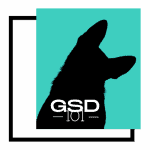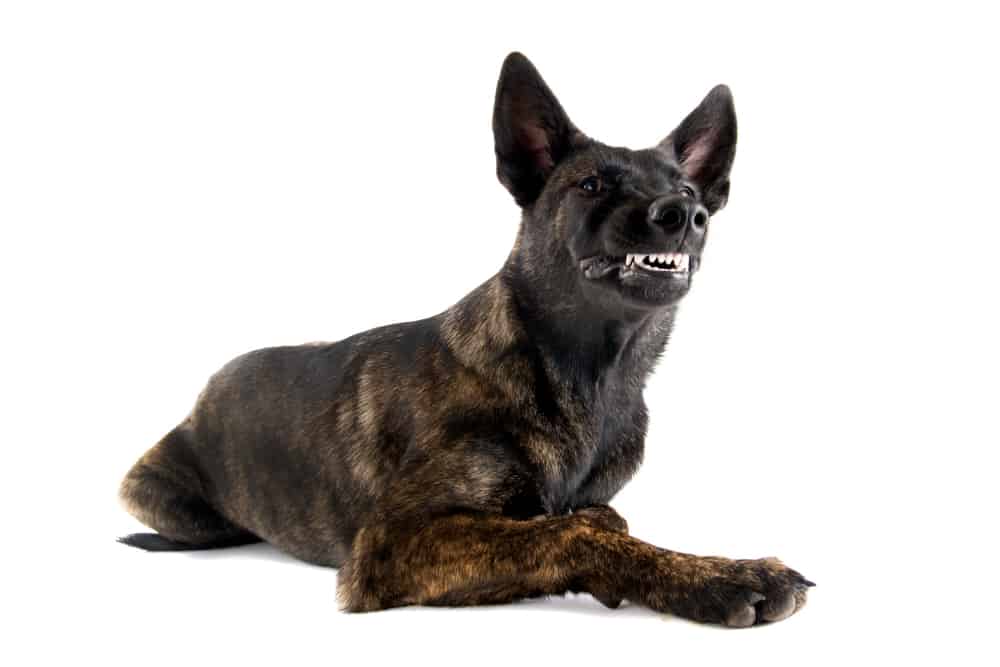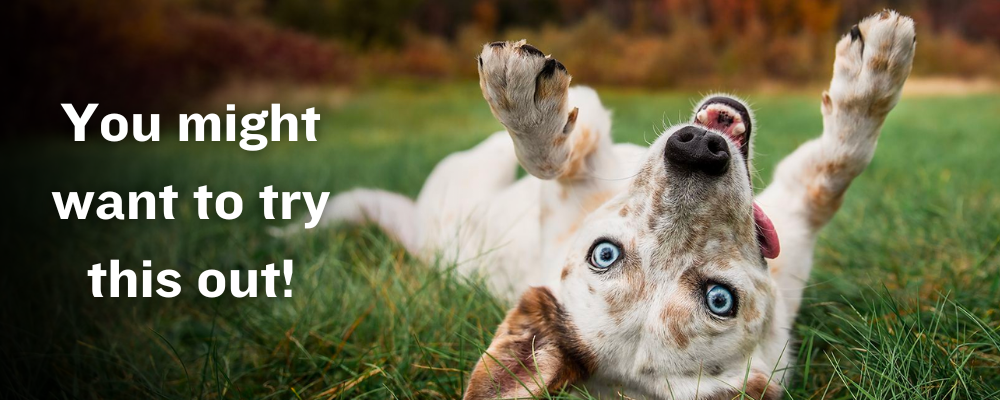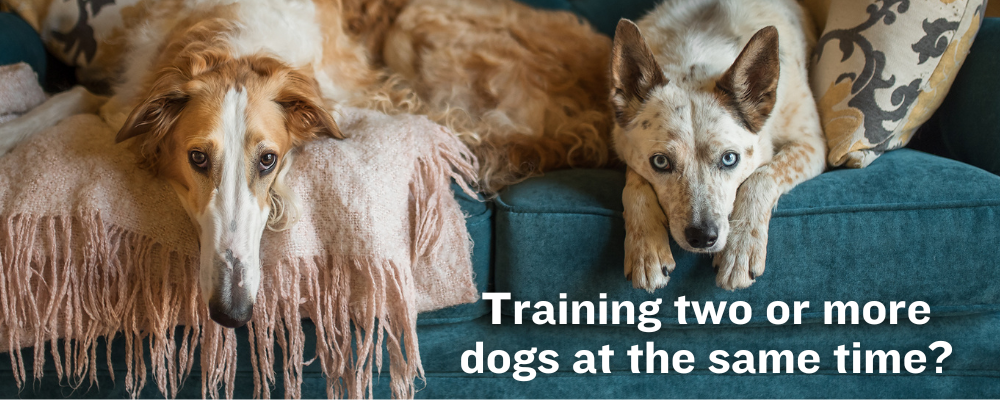When a German Shepherd growls at you, backing up and staying away seems to be the best bet. And that’s because we tend to interpret growling as a warning and associate it with aggressive behavior. However, do you know there are more than one kind of growl?
Growling, like barking or whining, is one of the many ways that dogs communicate. But not all growls result in aggression. The different kinds of growls that dogs make can express different meanings, such as fear, resource guarding, playfulness, affection, frustration, and pain.
This article will help you better understand why your German Shepherd is growling and what you should do about it. Whether you’re a new or experienced German Shepherd owner, this post will provide you with the information you need to create a happier and more peaceful home.
1. Aggressive growl: “You’re gonna get this!”
An aggressive growl is one of the most noticeable growls of all. The body language of your dog is stiff, and you’ll likely see snarling and teeth showing. Their hair will also raise up at the back.
One of the most significant signs of an aggressive growl is that a dog would inch forward to reduce the distance between him and the target. See this in action in this video, when a Rottweiler gets aggressive and tries to jump toward the woman:
When aggressive growlers are with other dogs, it may mean they wish to show dominance and start a fight.
What should you do?
A dog who is aggressively growling is dangerous. He is ready to attack.
Don’t risk the safety of your dog and others by allowing this aggression to continue. If you are on a leash, immediately leave the area.
There are many causes of dog aggression. And it may lead to serious problems if left untreated. If your dog continuously growls aggressively, you should seek professional advice from a dog trainer or behaviorist.
Related post: Can a German Shepherd Dog Kill You? (With Stats and Real Cases)
2. Fearful growl: “Leave me alone!”
When dogs are in fear or feel threatened, they are feeling insecure.
A fearful growl is often characterized by a low rumbling growl with a closed mouth. You’ll notice your pup exhibits stiff body language, and they may be holding their breath.
In contrast to the aggressive growl, a fearful dog will increase the distance between itself and the threat by backing up.
What should you do?
If a dog growls at you out of fear, the best thing to do is just give them their space for a while. Instead of going after your dog, you should let your dog come to you for something pleasant, such as a treat or a toy.
If your dog is leashed and growling at something (or someone) else, it’s best to take your him away from the scene to leave some space so he can calm down more easily.
3. Resources guarding growl: “Stay away from my property.”
If anyone happens to encroach on a dog’s property, food, or even toys, they won’t hesitate to let you know. This is often exhibited with a low growl with sharp barking.
It’s not uncommon for some dogs to start growling if they’re being bothered while eating. This video below shows you exactly what it is like when a golden retriever is disturbed by an unfearful pal getting too close to his food bowl.
Some companion dogs tend to become obsessive over their owners. And when a stranger approaches them, the pup may flick into guarding/protective mode.
What should you do?
Often, the best way to ease their growling is to simply back away from the property.
This should solve the issue quickly and with no additional stress. After all, they’re not after you. They’re just guarding their territory.
4. Playful growl: “This is super fun!”
Dogs can be very expressive during play sessions, and their growls may sound frightening to some bystanders and even inexperienced dog parents.
A lot of dogs will growl when playing games such as tug-of-war. Or they might growl at other dogs when wrestling or chasing.
This kind of growl has nothing to worry about. Here’s an example of a playful growl of a Great Dane while playing with his puppy mate:
What should you do?
There’s nothing wrong with a playful growl. But you should be attentive to your dog’s body language.
If you observe that the growls are getting more intense, you may simply wish to stop play for a while until things calm down before resuming.
Once the energy winds down, you can start playtime again. This will help you make sure that play growling doesn’t escalate to a fight.
5. Affectionate growl: “That feels great, give me more!”
Some dogs growl to show affection or contentment. It’s a kind of low growl that somewhat resembles snoring. Their body language is relaxed and loose. More often, they are leaning against you.
Also read: How to Tell if Your German Shepherd Loves You?
In general, an affectionate growl like this is nothing to worry about either. Listen to how gentle it can be in this video:
What should you do?
You should keep petting or rubbing your dog in a gentle way. It’s usually only a problem when people misinterpret it as aggression. And if you know your dog does this, make sure that anyone petting them understands that it’s normal and not to be afraid.
6. Frustrated growl: “Ahhh…that’s not what I want!”
Frustrated growls happen when your dog’s need or desire is not being met. Or he is put into an uncomfortable situation.
It usually has a varied pitch and frequency to them. Your pup may even start to whine while growling. Their body language is less stiff and looks like he is losing control.
For instance, your dog may growl in frustration when he is forced to have his nails cut and take a bath. Check out this video and you will know what it looks and sounds like:
While frustration growling is non-aggressive by nature, that doesn’t mean it isn’t an issue. And that’s because any other dog or person around them may misinterpret this as aggression and it could lead to a fight.
You may also like: How to Prepare Your German Shepherd Dog for Going Back to Work?
What should you do?
As an owner, you need to learn to read your dog’s body language. And if you could tell this is frustration rather than a fearful growl, you will be able to try to satisfy your dog’s need or simply redirect his attention.
You may need help from a professional trainer on how to ease your dog’s reaction if they don’t get what they want right away.
7. Painful growl: “Ouch! It hurts, I might need help.”
One of the most common signs of pain in dogs is growling. These growls are normally accompanied by yelping. Yelping is a high-pitched sound that can range from a small squeak to full baying. Sickness and injury can be another reason why dogs growl.
What should you do?
You should observe your dog carefully. Did he hurt himself? Is he limping in another direction? Or do you notice any behavioral change?
If the pain or infected area has deteriorated, the intensity of the growling will increase. This isn’t because they don’t like you, but because they’re afraid that more harm will come.
The painful growl is a clear signal that your dog can take it no more and the best way is to take him to the veterinarian.
Final thoughts
Remember when your German Shepherd growls it’s not bad behavior, simply an emotion they’re trying to commuinicate. Knowing the difference between different kinds of growls will help you take better control of the situation. A good part of this is understanding the implication of the growl and the body language.
And do you wish to speak dog? Or even teach your dog to talk to you?
Check out this post for more resources: 10 Books Every German Shepherd Owner Must Read
Further questions
Is growling always mean aggressiveness?
The most common reasons dogs growl are fear, possession aggression, territoriality, and pain. Some dogs also growl when playing. In this case, the growling does not necessarily indicate aggression.
Should I stop my German Shepherd from growling?
The short answer is no.
Growling is one of the many ways that dogs communicate. If you try to suppress your dog from growling, you’ll be teaching him to eliminate a fundamental part of his way of communicating.
In the future, he may choose not to warn you by growling, but go straight in and bite. The key to getting a dog to stop growling is not to suppress the growls, but rather to understand the causes and deal with the underlying problem.
Should I ignore my dog if he growls?
Do not ignore the growl and continue to approach or force the dog to do something against his will. Instead, try to understand what your dog is trying to convey to you and see what you can do about it. For instance, if he growls in pain, you should take him to a vet.
Why would a German Shepherd growl at a child?
If your dog growls at your child he is sending one of the warning signs that he is very uncomfortable with the situation or proximity of the child. Be grateful that your dog chose to warn with a growl rather than going straight to a bite. Immediately separate the dog from your child. Take your dog to the vet to see if he is sick or in pain.
More posts on German Shepherd aggression
- Are German Shepherds Dangerous? Here’s What You Need to Know
- Why Is My German Shepherd Suddenly Aggressive Towards Me?
- Why is My GSD Suddenly Aggressive Towards My Husband?
- Why Is My German Shepherd Aggressive Towards Strangers?
- Will A German Shepherd Attack an Intruder Untrained?
- How To Tell If a German Shepherd Puppy Is Aggressive?
- How to Stop Food Aggression Towards People in German Shepherds?
- Why Do German Shepherds Growl? And What Should I Do About It?



